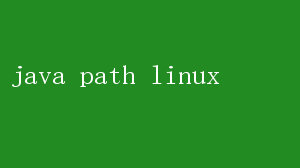Linux下Java环境路径配置指南
java path linux
作者:IIS7AI 时间:2025-01-09 23:23

Java Path in Linux: Unlocking the Power of Java Development on Linux Systems In the vast landscape of programming languages and operating systems, Java and Linux stand as towering figures, each contributing uniquely to the technological ecosystem. While Javas write once, run anywhere mantra has revolutionized cross-platform development, Linuxs robust, flexible, and open-source nature has made it a favorite among developers and system administrators alike. Combining these two powerful entities can unlock a treasure trove of capabilities, especially for those venturing into the world of Java development on Linux. This article delves into the Java path in Linux, exploring the essential steps, tools, and best practices for setting up a seamless and productive Java development environment. Understanding the Synergy Between Java and Linux Before diving into the technicalities, its crucial to understand why Java and Linux complement each other so well. Javas platform independence, robust standard library, extensive ecosystem, and strong community support make it an ideal choice for building scalable, maintainable, and secure applications. Linux, on the other hand, offers a stable, customizable, and resource-efficient operating system that provides a solid foundation for development. Linux distributions like Ubuntu, Debian, Fedora, and CentOS come with robust package managementsystems (e.g., apt, yum, dnf) that simplify the installation and management of software, including Java Development Kits(JDKs). Furthermore, Linuxs powerful command-line interface(CLI) and extensive documentation cater well to developers who prefer a text-based environment for efficiency and precision. Setting Up the Java Development Environment on Linux 1. Installing the JDK The first step in setting up a Java development environment on Linux is installing the JDK. Oracle JDK, AdoptOpenJDK, Amazon Corretto, and IBM Semeru are popular options, each offering different licensing terms and support levels. For Ubuntu/Debian-based systems, you can use the following commands to install AdoptOpenJDK (as anexample): sudo apt update sudo apt install -y apt-transport-https sudo wget -qO - https://adoptopenjdk.jfrog.io/adoptopenjdk/api/gpg/key/public | sudo apt-key add - sudo add-apt-repository deb https://adoptopenjdk.jfrog.io/adoptopenjdk/deb/ package main sudo apt update sudo apt install -y adoptopenjdk-11-jdk For Fedora/CentOS-based systems, use: sudo dnf install java-11-openjdk-devel 2. Verifying the Installation After installing the JDK, verify it by checking the Java version: java -version You should see output indicating the installed JDK version and vendor. 3. Setting JAVA_HOME and PATH Variables Setting the`JAVA_HOME` environment variable is crucial for many Java tools and applications. Additionally, ensuring thatthe `PATH` variable includes the JDKs`bin` directory allows you to run Java commands from any terminal. You can add the following lines to your shell configurationfile (e.g.,`~/.bashrc,~/.bash_profile`,or `~/.zshrc` depending on yourshell): export JAVA_HOME=/usr/lib/jvm/adoptopenjdk-11-hotspot-amd64 Adjust the path as per your installation export PATH=$JAVA_HOME/bin:$PATH Reload the configuration file with: source ~/.bashrc or ~/.bash_profile, ~/.zshrc, etc. 4. Installing an IDE While you can develop Java applications using a simple text editor and the command line, using an Integrated DevelopmentEnvironment (IDE) can significantly enhance productivity. Popular Java IDEs include IntelliJ IDEA, Eclipse, and NetBeans, all of which have Linux versions. For example, to install IntelliJ IDEA Community Edition on Ubuntu/Debian, you can use: sudo snap install intellij-idea-community --classic On Fedora/CentOS, you might need to download the`.bin` file from the official website and run it: wget https://download.jetbrains.com/idea/ideaIC-2023.1.tar.gz tar -xzf ideaIC-2023.1.tar.gz cd idea-IC-2023.1/bin ./idea.sh 5. Configuring Build Tools Java projects often rely on build tools to automate compilation, testing, packaging, and deployment. Apache Maven and Gradle are two of the most popular options. To install Maven on Ubuntu/Debian: sudo apt install maven On Fedora/CentOS: sudo dnf install maven Gradle can be installed using its official binary distribution: wget https://services.gradle.org/distributions/gradle-7.4.2-bin.zip unzip gradle-7.4.2-bin.zip sudo mv gradle-7.4.2 /opt/gradle export GRADLE_HOME=/opt/gradle export PATH=$GRADLE_HOME/bin:$PATH Add the`export` commands to your shell configuration file and reload it. Enhancing Your Development Workflow 1. Using Version Control Systems